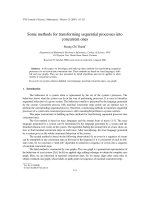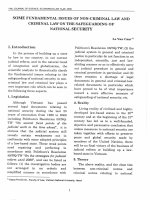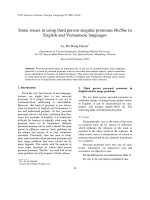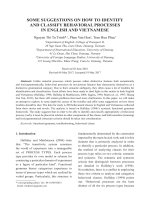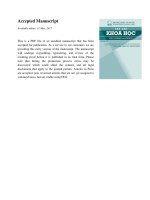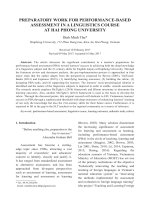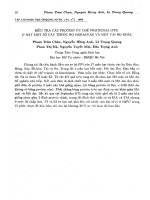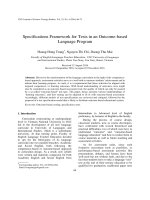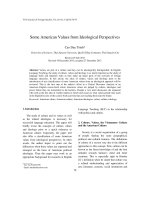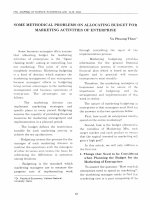DSpace at VNU: Some methods for transforming sequential processes into concurrent ones
Bạn đang xem bản rút gọn của tài liệu. Xem và tải ngay bản đầy đủ của tài liệu tại đây (1.19 MB, 9 trang )
VNU Journal of Science, Mathematics - Physics 23 (2007) 113-121
Some methods for transforming sequential processes into
concurrent ones
Hoang Chi Thanh*
Department o f Mathematic Mechanics Informa(ics, Colỉege o f Science, VNU
334 Nguyen Trai, Thanh Xuan, Hanoi, Vietnam
Received 31 October 2006; reccived in rcvised form 2 August 2007
Abstract: In this paper we investigatc and build up three methods for transíorming sequential
processes of a net system into concurrent oncs. These mcthods are based on: trace languages, shiftlcft and case graphs. They arc also prescnlcd by detail algonthms and can be applicd to other
modcls of concurrcnt systems.
Keywords: net system, reliance alphabet, trace language, maximal concurrent steps, case graph.
1 . Introduction
The bchaviour of a system often is rcpresented by the set of the system’s processcs. The
behaviour shows whal the system can do in the way of períbrming processes. It is easy to formalize
sequcntial bchaviour of a given systcm. The behaviour usually is presented by the language gcnerateđ
by the system. Concurrent proccss with maximal concuưcnt steps points out an optimal way to
perform the coưesponding sequential process. Thercíbre, constructing mcthods to transíbrm sequcntial
proccsses of a system into concurrent processes is still a mcaningful problem in systcm Controls.
This paper conccntrates in building up thrce methods for transforming sequcntial processes into
concurrcnt ones.
The first method is bascd on trace languages and the normal form of traces [1-3]. The trace
language generated by a systcm can be detcrmined by thc languagc generated by a system and the
detached rclation overevents of thc system. The algorithm íìnding thc normal form of a trace shows us
how to íìnd maximal concurrent stcps on each trace. Aftcr normalizing, the tracc language gcncratcd
by a systcm gives us the vvhole concuưent behaviour of the system.
The second melhod is bascd on the following observation [4]: an cvent in a scquence of events
can be attemped on any concurrcnt step on thc head of the sequence if it is concurrent of each its ]eftside evcnt. So we construct a “shift-left” algorithm to transíbrm a sequence of events into a scqucnce
of maximal concurrent steps.
The third method is constructed by casc graphs. The case graph is a geometrical rcpresentation of
the behaviour of a net systcm [5,6]. In [6] we applied edge adding technique to obtain the complete case
graph. Hcrc, we arc interestcd in maximal concuưent steps. So we mcrge edgcs aíter some rules to
obtain a rcduced case graph, whose labels on paths point out scquences of maximal concurrent steps.
•Tcỉ.: 84-4-5585840
E-mail: thanhhc@ vnu.cdu.vn
113
Hoang Chi Thanh / VNU Joum al o f Science, Mathematics - Physics 23 (2007) Ị1 3-121
114
A popular model to represent concurrent systems is a net systcm. Wc recall somc important
notions.
7. /. Net systems
Based on a simple Petri nct, a net system is deíìned in [2,3,5] as follows.
Deỷỉnitìott lĩ A triple N = (B, E; F) is called a Petri net iff:
1.
B, E are two disjoint sets,
2.
F c (B X E) u (E X B) is a binary relation, the flo w reỉation o f N.
Elements of the set B present conditiotis and elements of the sct E prescnt events of the system.
The flow relation F shows the relationship between two thcse objects.
Let N = (B, E; F) be a nct. For X e XN= B VJ E,
’x = ị y \ 0 .-v)eF} is called thepreset ofx,
x ' = {y I (x>>)
6
F } is called the postset of X.
The net N is called simple iff distinct elements do not have the samc pre- and postset.
Each subsct c c B is called a case of the net N.
Let e e E and c c B . The event e is c-enabỉed iff V c c A è n c = 0. Then, c 9= (c \*é) u è is
callcd the fo!lower case of c under e (c' rcsults from thc occurrence of e in thc case c) and wc vvrite:
c[e > c \
The occurrence o f events on the net N forms a forward reachability rclation rN c 2B X 2B,
defincd as follows:
V c, c ' G 2b : (c, c ’) e rN o 3 e 6 E, c[ e > c \
The reílexive and transitive closurc of the forward and backward reachability relation, RN= (rN
*
^ rN‘l) gives us thc reachabỉlity relation ovcr the net N. It is an equivalence relation over the 2B.
DeJĩniíỉon 2: A quadruple I = (B, E; F, Co) is callcd a neỉ system iff:
1.
N = (B, E, F) is a simple net without isolated elements.
2.
Coc B is a casc (the initiaỉ case) of the net N.
The equivalcnce class c = [c0]r is called the S t a t e
sp a ce
of I .
Anevcnt e may occur in a case c if and only if the preconditions of e bclong to c and the
postconditions of e do not bclong to c. When e occurs, the preconditions ofe ccase to hold and the
postconđitions of e bcgin to hold. After the occurrence of an event, the obtaincd follower casc must
belong to the State space. Othcr events may be enabled by this case. A systerrTs State spacc is thc
environment for occurrence of steps on the system. The net systcm is uscd to model concurrcnt
systems, such as communicating systems, operation systems, industrial production systems, concurrent
programs ...
Let E = (B, E; F, Co) be a net system and there are a sequence o f cascs
C\, c2 , ... , cn , cn>ị
belonging to c and a sequencc of events €\ , e2, ... , en belonging to E such that:c, [ e x> Cm >i= 1, 2,
... 9 n.
Then the sequence:
c][ e ]> c2[e2> Cs ... c n[ en> C„H
presents a sequential process occurred on the system.
Definition 3: The language generated by z is defincd as follows:
L ( I ) = {e\e2 ... en I 3 c b c2, ... , cn, cn*i e c , 3 e u e 29... , e n G H :
CiOi>Ci+i >i = 1 ,2 ,... ,/ỉ}.
Hoang Chi Thanh / VNU Journaỉ o f Science, Mathematics - Phvsics 23 (200 7) 113-121
115
The language generated by a net system describes all sequences of evv..iS occurred on the
system. It is used to represent the systcm’s bchaviour. But the language shows us only the sequcnces
of events, which occurr sequentially on the system. So how to dctect the system’s behaviour, in which
some events may occuư concurrently? Futhermore, can we result it from the sequential language of
the systcm?
In the next sections, we build three methods for transforming sequential processcs into
concurrent ones.
First of all, we formalize concurrent steps on the net system.
1.2. Concurrent steps on a net system
Let £ = (B, E; F, Co) be a net system.
Definition 4:
1.
A relation q c E XE is called a detached reỉation iff:
V e u e2 e E : (
o
A 'ẽị n 'e 2 = V| n e2'
= e ' n 'e 2 = (?i*n e2'~ 0 .
2.
A subset G c E is called a detachedset iff:
V e,, e 2 e G , e t * ei => (elt e2) e q.
3.
Let c, c ' be cases and G be a detached set. G is called a síep on I from c to c ' iff each
e e G is c-cnabled and c ’ = ( c \ *G) u G*.
Then we dcnote: c[ G > c
Of coursc, the detachcd relation is symmetrical and iưeílexive (sir-relation). If G is a stcp on
the net system E then the events bclonging G can occurr concurrently. Thereíbre, quick deteưnining
concurrcnt steps on a net system becomes a mcaningful problem. Usually, we are interested in, as big
as possible, concurrent steps.
Theorem 1 [4]: Let G be a detached set on a net system I and let c, c ' be two cases of I. Then:
c [G>c’
( c \ c ’ = *G) A ( c ' \ c = G*).
The above theorem can be used to detect concurrent steps on a net system. But the complexity
of the corresponding algorithm will be very high.
2.
Concurrency transíormation by trace languages
The theory of ừaces was originated by A. Marzurkiewicz in [2] as an attempt lo provide a good
mathematical dcscnption of the bchaviour of concurrent systems. The normal foưn of a trace gives an
optima! way to perform a process represented by the trace. So we apply trace languages to net
systems.
Defìnition 5: Let A be an alphabet.
1. An independence relalion ovcr A is a symmetric and irreílexive binary relation p over A.
V a, b G A : (a,b) e p <=> (b.a) e p
a #b.
2. A reliance alphabe 1 is a couple (A, p), vvhere A is an alphabet and p is an independence
relation over A.
Considering adjacent independent symbols in a string to be commuting, one can relate different
strings as folIows.
Let Jĩ = (A, p) be a reliance alphabet.
Hoang Chi Thanh / VNU Joum al o f Science, Mathematics - Physics 23 (2007) 113-121
116
1.
The relation ~p c A* X A* is deíĩned as follow: for X, y e A \ X ~v y iff there exist Xj, X:
e A* and (a.b) e p such that X = x/abxi andy = x/bax>.
2.
The relation =p c A* X A’ is defmed as the least equivalence relation over A ’
containing ~p. The relation «p is indeed the reílexive and transitive closure of ~p.
Thus, ~p idenlifies ‘commutatively similar’ strings - each such group of strings is called a trace.
DeỊìnitìon 6 : Let ý? = (A, p) be a reliance alphabet.
1.
For an X e A , the trace o f X, denoted by [x]p , is the equivalence class of
containing X .
Wp
2.
A set of traces over JA. is called a trace language over X
For traces //, tỵ over Jĩ, the trace composition of tị and t2, denoted by t/.h, is defmed by t r h =
[jf/.jr;]p, where x
h Xị e
A* are representatives of // and
ÍỊ
respectively.
In general, a trace can be obtained as a tracc composition of othcr traces, but trace
decompositions of the given trace do not have to bc unique. Hence it is desirable to have ‘normal
form’ decomposition of traces.
Definition 7: Let ^ = (A, p) be a reliance alphabet and let í be a trace over ýỉ. The following
decomposition / = ịị.t2. ... tm> such that:
1.
for all 1 < / <, m, tị *■ A;
2.
for all 1 < i <, m, ti can be written as [M,]p ,where
Ui 6 A*, #a(M,) = 1 for cach a
6
alphíu,), and (a,b) e p for all a, b e alph(Mj) such that a #b\
3.
for all 1 < / <, m -l, if ti = [w,]p and /i+/ =
then, for each a 6 alph(«í4/),there
exists b e alph(«i), such that (a,b) í p;
is called the normalform of the trace t.
In [1] J. I. Aalbersberg and G. Rozenberg pointed out that every trace can be uniquely
decomposed into a normal form, i.e. a minimal number of ‘maximal independcnt’ parts. They have
built two algorithms for fmding the nonna! form of a trace. The íìrst algorithm is based on intcger
pointers and the second One is bascd on dependence graphs. We recall the first onc.
Algorithm 2 [1]:
Input: A reliance alphabet
= (A, p) and a string IV 6 A*.
Declaraíion: Let / = |w| , n = #A and A = {ah a2, .... a„}\ let k be a variable over {0, 1, ...,/}
and let d be an aưay of length n over {1, 2,
/+1}; let i , j be variables over {1, 2,
n}\ Jet u be an
array of length / over (A u {X})*; let m be a variable over {1,2,
Computatỉon:
1.
ForaIl /= 1, 2 , n, d(i) := 1
2.
For all k = 1,2,
«(*):= X
3.
k:= 0
4.
k := k + 1
5.
set j such that w(k) = ơj
6.
«(d(/')) := u(á(J))aj
7.
For all / = 1,2,...,« such that i * j , d(i) < dự) and (a„ c7)) Ể p, d(j) := d(/)-H
8.
ỏự) := d(/) + 1
9.
if k < ì then goto 4)
10.
set m such that uỤn) * X and either «(w+l) = X.or m = l
11.
stop.
Output: The strings m(1), u( ĩ ), ..., u(m).
Hoang Chi Thanh / VNU Journal o f Science, Mathematics - Physics 23 (2007) I I 3-121
117
Each vv 6 A* gives the corresponđing trace t = [w]p, applying the above algorithm we obtain the
normal form of t = [w( 1)]p.[«(2 )]p... [z<(w)]p, where thc steps «(/) are maximal independent.
Example 8: Let Ạ = (A, p) be the reliance alphabet given by the following undirected graph.
Lct vv = aecbbed. Computing by the algorithm 2, we obtain uỤ) = ab, u{2) = bce, w(J) = de.
This means the normal form of the tracc t = [w]p is [ab]v.[bce]v.[de\ . So, instead of performing the
sequential process in 7 steps, one can períòrm it concurrently in 3 steps.
Now we apply thc above technique to net systems. Let s = (B, E; F, C o ) be a net system. The
rcliance alphabet deíìned on the net system is
of the nct System.
Using the algorithm 2 to find normal form for each trace, vve get concurrent processes with
maximal concurrcnt steps on the given nct systcm.
Note that the input of thc algoritlim 2 is a representative of the trace. Hence, the algorithm 2
transíòrms directly strings of the language L(I) into the set of normal fomis of traces. This is just the
sct of all sequences of maximal concurrent steps on E.
Example 8: Consider the net system I given by the following directed graph.
The set of events E = {eI, e2, ej, e4} and the detaclied relation q = {(e/,eẠ
The
language generatcd by I is L(E) =
, Cyejeĩe^ị. It is just the trace language V(I) generated by
thc net system z.
Applying the algorithm 2 to strings of L(Z) vve get the sequence of maximal concurrent steps
{e / ị , { e 2. e j } , ị e4). Thus, events e 2 ande^ may be períormed concurrently.
Hoang Chi Thanh / VNƯ Joum al o f Science, Mathematics - Physics 23 (2007) ! 13-121
118
In this technique, we recognize that the cases Cj were hidden. But the following result ensures
the íìnding normal form of the trace t on the net system is correct.
Theorem 3: Let Cị [ e\ > c2 [ e -1 > c 3 . . . C j [ e\> Cj+| [ eit| > Ci+ 2 — c„ [ e„ > < v 1 be a sequence o f
activities on a net system I . If
ej+i) e q then ei+1 is C\ -enabled. In other words, Cj [{e\, ej*i} > Cj+2
and {ej, e^i} becomes a concurrent step on I.
Proof:
By the deíinition o f the reachability, Cjt | = (Cj \ ' e i ) u e * .
Futhermore, Ci+1 enables ej+i then *ei+| c Cj+1 A ei+| ' n Cj+| = 0 . So,
Vj*i c ((Ci \ ‘e ) u £(*) A
ei+I* n ((Cị \ Vi) u C'i*) = 0 . Because ei and e,+i are detached then *ei+| CC| A gị+i* n Cj = 0 . Thus eị.ị is
Cj -enabled and {ei, ej*i} is a concurrent step on the net system I .
r/ỉe complexiỉy o f the algorithm: The transíbrmation is executed on strings of the language
generated by a net system £. The length of each string (or its cycle) belonging to L(E) is not greater
than |C|. So, by [1] the complexity is 0(|E|.|C|).
Each case can enable at most |E| events. Thus, the language generated by I consists of at most
|E||C| strings. Then the total complexity of the above algorithm is 0(|C|.|E||C|‘').
3. “Shift-left” algorithm
Let c , [ G , > c 2 [ G 2> c 3 ... Cị[ G j> Cj+| [ Gjt | > Cj+2 ... c„ [ G n> c„n be a concuư ent process o f
the net system I.
If there are some events belonging to Gj+1, when adding them to the previous step Gi , the
obtained set is still detached and is c-enabled, then we shift these events írom the step Gịti into the
step Gj and change the case cÍH appropnately. After shiíìing, if the step Gj+ị becomes empty then we
ignore both CiMand Gjf|. Repcat this until no event can bc shifted.
When the algorithm terminates we get a sequence of maximal concuưent steps of thc given net
systcm E.
The input of the algorithm is a sequence of single events. This sequence may be considered as a
sequence of concuưent steps, where each step consists of only one event.
Algorithm 4 ( ‘Shift-left” algorithm):
ỉnpuV. A sequence o f activities c I [et > c2 [e2> Cj ... c„ [en> Cn+I on the net system z.
Computation:
1. for i := 1 to n do Gi := {e,} ;
2 .for j := 1 to rt-1 do
3.
begin
4.
5.
6.
7.
8
.
9.
10.
11.
12.
/ := j ;
while / ằ 1 do
begin
for every event e e Gj4| do
if GjU{e} is detached ACị enables (GjU{e})
begin
Cj*i :=(Cit]\’e )u e ';
Gj := GjU {e} , Gj+1 :=Gj+|\
i f G i+i = 0
then
{e}; {shift the event efrom Gj+| into Gj}
then ignore both Cj+| and G i+1 ;
Hoang Chi Thanh / VNU Joum aỉ o f Science, Mathematics - Physics 23 (2007) 113-121
119
13.
end;
14.
i:= i-\
15.
end;
16.
end.
Outpuí: A sequence of maximal concurrent steps on I.
The algorithm goes back because we want not only making steps maximal concurrent but also
reducing the number of steps.
The algorithm 's complexity: The algorithm transforms a sequential process into a concurrent
one vvith the com plexity o f 0 ( |C |2).
Thereĩore, the total com plexity o f the algorithm is 0 ( |C |2.|E||C|).
Example 9: Applying the “shift-left” algorithm to the net system given in Example 8, we get the
following sequence of maximal concurrent steps {ei},{eỊ, e}},{ e4}.
4. Reducing case graphs
To view broadly all proccsses happcned on a nct system we costruct a case graph of the
system. It is a directed graph, whose nodes are cases of the nct system and labcls on eđges describe the
occuưence of events on the net system.
Definition 10: Let E be a net system. Construct the following set of labellcd edges.
p = { (c,
e , c ’) e c X E X c I c [ e > c ’ }
Labelled directed graph <t>= (C, P) is called a case graph of the net system X.
Li the case graph í>, each edge (c, e , c ’) can bc considered as the edge (c, G , c") with the
single stcp G = {£*}. Thereíore, thc labels on cdgcs are steps. In ordcr to fĩnd maximal concuưentsteps
on I, we reduce the case graph of the net system. The reducing is bascd on the following results.
Theorem 5: Let I be a nct system and let C/, Cỵ, Cí 6 c ; G|, G2 c E.
If (C|, G|, c2) and (C|, Gĩ, Cì) are two edges of the case graph O, G| n G2 = 0 then (c2, G2, c4)
and (Cj, G|, c4) with c4 = (C| \ *G) u G* are just two edgcs of the graph o and if G = G| u G2 is
dctached then C) [ G2 > CA.
Proof:
Since C|[ G) > c2 then *G| c C\ , G|’ n c, = 0 and c 2 = (Ci \ *G|) u G|*.
Sim ilarly, since C|[ G2 > Cj then *G2 c C| , G 2* n í| =
0 and C3 = (C| l’ G 2) w G 2*.Futher,
*G2 c Cỉ and G2*n c 2 = 0. Thus c2[
because G|, G2 are dctached and Gi n G2 = 0 then we have
G2 > c4 with C4 = (c\ \ *G) u G*. Analogously, we prove that c3[ Gi > c4.
Because the set G is detachcđ then Ci[ G > C4 .
Theorem 6 . Lct I be a net system and let c I, c2, c 3 € c ; G|, G2 c E.
If (C|, G|, c2) and (c2, G2, C3) are two edges on thc case graph (p then G| n G2 = 0 and (C|, G2,
c4), (c4, G |, c3) with Ca = (Ci \ *G) u G* are two edges of the graph c> and if the set G = G| u Gị is
detached then c,[ G > C}.
Proof:
Assume that e 6 Gj. Thus ‘e n c 2 = 0 . So e is not c 2 -enabled. It means e e G2. We have G! n
G2= 0 .
120
Hoang Chi Thanh / VNU Journal o f Science, Malhematics - Physics 23 (2007) 113-121
Since *G| c cI and *G2 Q cI we get *G| u 'G2 CỊ C|. Futher, bccause G = G| u G2 is detachcd then
*G = *G| u *G2 c C|. Analogously, because Gi* n C\ = 0 , G2*n c, = 0 we have (G)* u G2*) n C| = 0.
Hence G2 is cr enabled and we get Ci[ G2 > C 4 with C4 = (ti \ *G2) u G2*and c4[ G| > c3. Since G
= Gi u G2 is detached then G* = G|* u G2*. We have G* n C| = 0. It means C| [G > C3.
Using Theorem 5 and Theorem 6 above, we build an algorithm to reduce case graphs as
follows.
Algorithm 7: Construct the case graph c> = (C, P) of the net system E, whose label on each edge
is a single stcp.
If (Ci, G|, cì) and (Ci, G2, C3) are two edges of the graph, G| n G2 = 0 and G = G|
Gị is
detached then we remove 4 edges (C|, Gi, c2), (Ci, G2, C3), (c2, G2, C4 ) and (c3, G|, c4) with C4 = (C| \ *G)
u G* and add a new edge (C|, G, C4).
If (Ci, G|, Ci) and (c2, G2, c3) are two cdgcsof the case graph and G = G| u G2 is detachcd then
we remove 4 edges (Ci, G|, c2), (c2, G2, c3), (C|, G2,C4) and (C4, G|, C3) with = (Ci \ *G:) Gỉ' and
add a new edge (C|, G, C3 ).
Repeat the instructions 2) and 3) until no edges can be removed.
Note that, in the instruction 2) we have to check whether the sets G| and G2 are disjoint, but it is
no need for the instruction 3).
Sequences of labels on paths of the reduced case graph point out concurrent processes of the
net system I with maximal concurrcnt steps.
The algorithm 's complexity: We can use a searching algorithm (breadth-first search or depthỉlrst scarch) on the case graph to detect situations as in the instructions 2) and 3). The case graph
consists of |C| nodes and the degrce of each node is nol greater than |E|. Thus the complexity of the
graph searching is 0 (|C |.(|E |+ 1 )). The tim es o f searching are not grater than |E|. At every node, One
has to choose two its adjacent edges and check the disjoint of their labels and the detachment of the
union of these labcls.
Therefore, the total complexity of the algorithm is 0(|C|.|E|4).
Examplc 11: Consider the nct system I given in Example 8. The casc graph and the rcduced
case graph of the net systcm are the following.
{«. >
{b3.l>3) 0
a) The case graph
b) The rcduced casc graph
From the reduced case graph of the net system £ we get the sequence of labels on a path.
It is just the sequence of maximal concurrent steps {e/},{e?, e3},{ e<}.
Hoang Chi Thanh / VNU Jo u m a l o f Science, Mathematics - Physics 23 (2007) ỉ ỉ 3-121
121
ones can be applied in systcm Controls. Two íirst methods begin from the language generated by the
given system and use an algorithm to find the normal form of traces or the “shift-left" algorithm.
Thesc algorithms have the same complexity, but the second one is much simpler. The complexity of
thc third algorithm is the lcast. It is more complicated when computing on computers.
These methods can be applied to other mođels of distributed systems, especially to models vvith
dynamic environm ent or timed changing.
Acknow!edgements. This paper is based on the talk given at the Conference on Mathematics,
Mechanics, and Iníbrmatics, Hanoi, 7/10/2006, on the occasion of 50th Anniversary of Department of
Mathematics, Mechanics and Iníòrmatics, Vietnam National ưniversity.
Reíerences
[ 1] J.l. Aalbcrsbcg, G. Ro/cnbcrg, Theory o f Traccs, Theoreticaỉ Computer Science 60 (1988) 1.
[2] A. Mazurkicwicz, Concurrcnt program schcmes and thcir intcrprctations, DAIMỊ Report PB-78, Aarhus Univ.,
Denmark, 1977.
[3] Hoang Chi Thanh, Behavioural Synchronization o f Nct Systems, ĨMSc Report //5 , Madras, India (1991) 136.
[4] Hoang Chi Thanh,
Algorithms Transíorming Sequcntial Proccsscs into Concurrcnt Ones, Proceedings of the
Second National Symposium "Fundamentaỉ and Applied hìformation Technology Research (FA!R), Science &
Techniquc Press, 2006.
[5] w. Reisig, Petri Nets: An Introduction, Springcr-Vcrlag, 1985.
[6] Hoang Chi Thanh, Vu Trong Quc, Using casc graphs in concurrency control on nct systcms Proceedings of the y h
National Symposium on Ịnformaíion Technology and Communicatiotì, 2006.
